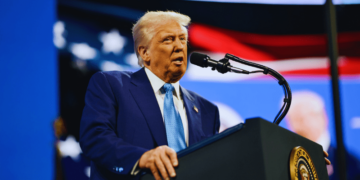This article originally appeared in The Hub.
By Trevor Tombe, February 6, 2025
In recent weeks, Canada has faced an unprecedented level of uncertainty, driven by federal politics, domestic policy debates, and major international trade tensions—especially the disruptive potential of tariffs.
A leading index of economic policy uncertainty, updated to include January 2025, shows Canada hitting a record high—surpassing even the peak uncertainty of the early COVID-19 months.

Just in the past few days, tariffs were announced, retaliatory measures detailed, and then—just as quickly—tariffs delayed by 30 days.
This rollercoaster is far from over. If the new U.S. administration’s goal is to create instability, it’s succeeding. It’s the era, as Anne Applebaum puts it, “performative trade war.”
But even if just performative, there are lessons in how Canada responded in recent days. Ones we should reflect on, and limitations we need to accept, to better prepare for the worst.
So how did Canada respond over the weekend?
We saw procurement contracts with American firms suspended. Liquor retailers pulled U.S. products, urging consumers to buy Canadian. The federal government also announced tariffs on $30 billion worth of imports.
While these moves likely had strong public support, none would seriously impact the U.S. economy.
That’s not to say they’re pointless. Symbolic retaliation has value when paired with a smart communications and government relations strategy targeting key U.S. decision-makers. But Canadians shouldn’t mistake these measures for ones that will impose meaningful economic costs south of the border—despite that being the stated aim.
Let’s start with booze.
Alcohol imports from the United States are relatively limited. Last year, Canada purchased roughly $1.5 billion worth of beer, wine, and liquor from the U.S., making up about a quarter of our total alcohol spending. While that’s a notable share of Canada’s purchases, it accounts for only about 0.5 percent of total U.S. alcohol production. Even if Canadian demand for U.S. products dropped by 20 percent—a substantial shift—the impact on total U.S. output would be just 0.1 percent.
What about government purchases?
In 2022, Canadian governments bought about $31 billion in goods and services from the U.S., but much of this is hard to replace. This includes $5 billion in machinery and equipment and $11 billion in medical equipment and pharmaceuticals, where domestic alternatives are limited. Relative to the U.S. economy, these purchases amount to just 0.05 percent of total output. Even a sharp reduction in Canadian government spending on U.S. goods would barely make a dent south of the border.
And finally, there are the retaliatory tariffs that Canada was going to levy. These aim to shift consumer and business spending away from U.S. goods and included a 25 percent tax on roughly $30 billion in imports followed by a second phase coming later to expand this to $155 billion—about 30 percent of Canada’s total purchases from the U.S.
The specifics of the second phase remain unclear, but we know which products were hit in the initial $30 billion round, allowing us to assess the impact on the U.S. economy. Below, I plot the share of each state’s GDP affected by these initial tariffs.

Any actual economic disruption will likely be much smaller. Take Wisconsin, for example—the most exposed state—where about 0.5 percent of its economy is tied to exports of goods subject to the 25 percent tariff. If Canadian consumers cut purchases of these goods by 25 percent, the resulting hit to Wisconsin’s economy would be just 0.15 percent of its GDP and an even smaller share of its total output.
The most affected states are also not necessarily those that strongly supported President Trump. There is no strong correlation between a state’s share of affected exports and Trump’s margin of victory, nor when looking at affected exports per resident. In both cases, the link to Trump’s vote share is only slightly positive. On average, blue states see 0.09 percent of their economies exposed, while red states see 0.13 percent.
The limited scale of the response was likely deliberate (though I have no insider knowledge) to avoid undue harm to the Canadian economy. It was not the dollar-for-dollar response some had called for—for a simple reason.
Roughly four out of every five dollars traded between Canada and the U.S. involves intermediate inputs—goods used in the production of other goods and services in Canada. Imposing tariffs on the $350 billion worth of these inputs that cross the border into Canadian businesses would disrupt production and carry significant economic consequences. To avoid this, the government initially targeted consumer goods that are easier to substitute, minimizing the risk of broader economic disruption. A wise decision.
That said, the response is not without costs. The immediate effect of these tariffs will be higher prices for Canadians.
This isn’t necessarily an argument against imposing tariffs in response to unjustified ones levied by the U.S.. As I noted earlier, retaliation plays an important role in lobbying and communications efforts. But Canadians should have no illusions—trade measures or boycotts alone are unlikely to cause meaningful economic disruption in the U.S.
Of course, a well-placed punch can sometimes have outsized effects (see: McFly v Biff). But as we prepare for the possibility—or threat—of broad U.S. tariffs returning in March, Canadians and their governments should focus on strengthening the country’s economic resilience.
Retaliation may be politically necessary in the short term, but it won’t move the needle in the U.S. the way American tariffs affect Canada. The size gap between our economies is simply too great for even significant tariffs on Canadian buyers to matter much to the U.S.
It’s a tough reality, but a reality nonetheless.
Trevor Tombe is a professor of economics at the University of Calgary, a research fellow at The School of Public Policy, and a senior fellow at the Macdonald-Laurier Institute.








